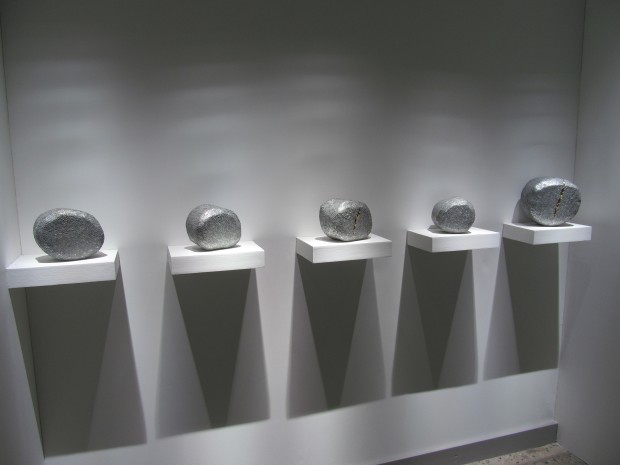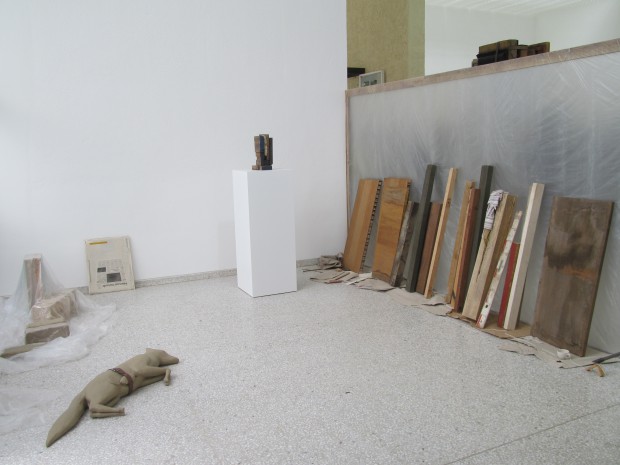Part two of our slideshow series on the Venice Pavilions, with comments on Spain, Hungary, Belgium, Finland, the Netherlands, the Nordic Countries, Denmark, Latvia, and Lebanon.
SPAIN

These piles by Lara Almarcegui refer to Sacca San Mattia, an area in the Venetian island of Murano, that acts as a landfill. Murano, which is famous for its glassmaking, is now reinvisioning the rest of the island as a high-end vacation spot for tourists who find the island of Venice too packed. In any event, these monochrome piles are too clean to refer to the multicolored landfill site, and instead looked like a homage to Robert Smithson. In the upstairs portion of the exhibition, Almarcegui provided a video documenting the island.
HUNGARY

Just weeks after Israel bombed Syria, the Hungarian Pavilion gives us an exhibition about bombs by Zsolt Asztalos. The videos showed a still of bombs which mysteriously failed to detonate, and were accompanied with soundtracks like a rave-inspired dance track repeating "only love can do it". Ick.
BELGIUM

What do you get when you combine the dark, pensive prose of J.M. Coetzee, with the Belgian Pavilion's artist Belinda De Bruyckere? A very dark room that's hard to photograph, and a rumination on all things related to knots. A knotted tree covered in wax and bandaged with cloth took up most of the pavilion. Mr. Coetzee was Belgian Pavilion's curator this year.
FINLAND

- Some people do yoga to feel physically closer to nature. Others make art. Antti Laitinen cleared an acre of forest and then organized the bark, soil, grass, and other bits into Forest Square (2013), a 10 meter x 10 meter square, photographed here. It’s a whole lot to organize nature into a grid, and it seems like the winning party here is the Laitinen. Dead trees, 0, artist, 1.

The theme of this year's Finnish and Nordic Pavilions, "Falling Trees", deals with a pesky tree that did, in fact, fall on the Finnish Pavilion in 2011. Antti Laitinen's silver armadillo shapes are rounded pieces of wood, hammered over entirely with nails. That idea didn't work entirely, though, and you can see the zig-zag shapes from parts of the wood that couldn't be nailed over.
THE NETHERLANDS

Mark Manders realized he usually sets a tea cup on his leg, and this is his small monument to that action. It's simple, thoughtful, and doesn't take itself too seriously.

Unlike the bone-and-cup work above, this setting was far less provocative. Still, the fox with a mouse attached around its rib with a belt, was at least unusual.
THE NORDIC COUNTRIES

Terike Haapoja's "Community", a 5-channel video installation from 2007 at the Nordic Pavilion shows the cooling down of an animal's body after it dies. "Closed Circuit, Open Duration" saddles several potted trees with electronic equipement that is apparently measuring CO2, changes in light, and sound waves. All this is supposed to encourage us to think beyond our senses, which is a little techno-utopic for my liking, but so be it. There's nothing else in the Biennale that even remotely looks like this, and maybe that's a good thing.
DENMARK

Lots of buzz about Jesper Just's installation, Intercourses, which is shot in black and white against a replica of Paris located in the Chinese metropolis of Hangzhou. No spoken narrative exists, but video nonetheless succeeds in creating an eerie feeling of displacement. There's a lot more to say on the installation, so look forward to our forthcoming review.
LATVIA

Kriss Salmanis's tree pictured above swings much like a pirate ship ride at an amusement park, thus making it impossible to photograph. It's perhaps fitting then, that invisible history defines this work; Latvia is at the north-easternmost boarder of the European Union and under Soviet rule, the westernmost limit of Russia, so we're told it embodies an imaginary Europe. The tree is dislocated, and the photographs of residents hovering above the snow by Kaspars Podnieks (not pictured here) suggest mystic identity. It's good to have this history, but perhaps better to let the work speak for itself. A swinging tree is powerful enough on its own to warrant reflection.
LATIN AMERICA

Based on the project presented by Martin Sastre, Uruguay's art funding isn't in great shape. For the Biennale, he created a perfume from Uruguayan president José Mujica's garden, which was then auctioned off to raise funds toward the establishment of a national contemporary art fund. The video, pictured above, uses a combination of aesthetics drawn from high-end men's perfume advertising and national propaganda. It's amazing.
LEBANON

"Letter to a Refusing Pilot" is a video installation by Akram Zaatari that reflects on his father's decision to disobey orders to bomb a school on the outskirts of Saida. His father was an Israeli air force fighter pilot. Arguably, the length of the video is a little long for the biennale experience (I watched about 12 minutes out of 30), which caused a couple of friends to speculate that perhaps the video would have benefited were it presented as a shorter, three-channel installation. I'm inclined to agree.




Comments on this entry are closed.